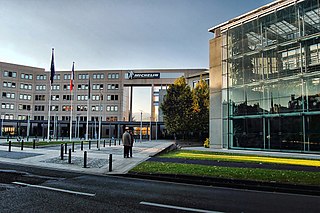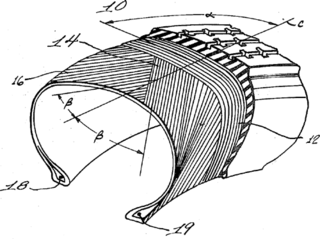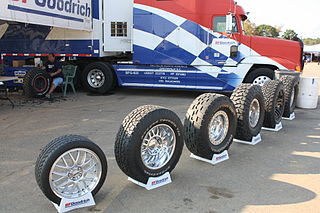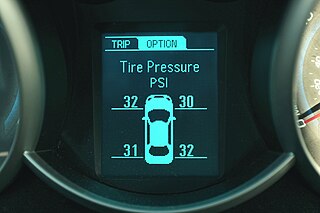
A tire is a ring-shaped component that surrounds a wheel's rim to transfer a vehicle's load from the axle through the wheel to the ground and to provide traction on the surface over which the wheel travels. Most tires, such as those for automobiles and bicycles, are pneumatically inflated structures, providing a flexible cushion that absorbs shock as the tire rolls over rough features on the surface. Tires provide a footprint, called a contact patch, designed to match the vehicle's weight and the bearing on the surface that it rolls over by exerting a pressure that will avoid deforming the surface.

Michelin, in full Compagnie Générale des Établissements Michelin SCA, is a French multinational tyre manufacturing company based in Clermont-Ferrand in the Auvergne-Rhône-Alpes région of France. It is the second largest tyre manufacturer in the world behind Bridgestone and larger than both Goodyear and Continental. In addition to the Michelin brand, it also owns the Kléber tyres company, Uniroyal-Goodrich Tire Company, SASCAR, Bookatable and Camso brands. Michelin is also notable for its Red and Green travel guides, its roadmaps, the Michelin stars that the Red Guide awards to restaurants for their cooking, and for its company mascot Bibendum, colloquially known as the Michelin Man, who is a humanoid consisting of tyres.

The Acura RL is a full size luxury car that was manufactured by the Acura division of Honda for the 1996–2012 model years over two generations. The RL was the flagship of the marque, having succeeded the Acura Legend, and was replaced in 2013 by the Acura RLX. All models of the Legend, RL and RLX lines have been adapted from the Japanese domestic market Honda Legend. The model name "RL" is an abbreviation for "Refined Luxury."
Tire rotation is the practice of moving the wheels and tires of an automobile from one position to another, to ensure even tire wear. Even tire wear extends the useful life of a set of tires, but the value of this is disputed.

The Tweel is an airless tire design developed by the French tire company Michelin. Its significant advantage over pneumatic tires is that the Tweel does not use a bladder full of compressed air, and therefore cannot burst, leak pressure, or become flat. Instead, the Tweel's hub is connected to the rim via flexible polyurethane spokes which fulfil the shock-absorbing role provided by the compressed air in a traditional tire.

A radial tire is a particular design of vehicular tire. In this design, the cord plies are arranged at 90 degrees to the direction of travel, or radially. Radial tire construction climbed to 100% market share in North America following Consumer Reports finding the superiority of the radial design in 1968, and were standard by 1976.

A self-sealing fuel tank (SSFT) is a type of fuel tank, typically used in aircraft fuel tanks or fuel bladders, that prevents them from leaking fuel and igniting after being damaged.

BFGoodrich is an American tire brand. Originally part of the industrial conglomerate Goodrich Corporation, it was acquired in 1990 by the French tire maker Michelin. BFGoodrich was the first American tire manufacturer to make radial tires. It made tires for the then new Winton car from Winton Motor Carriage Company.
Low rolling resistance tires are designed to reduce the energy loss as a tire rolls, decreasing the required rolling effort — and in the case of automotive applications, improving vehicle fuel efficiency as approximately 5–15% of the fuel consumed by a typical gas car may be used to overcome rolling resistance.

Automotive tires are described by several alphanumeric tire codes or tyre codes, which are generally molded into the sidewall of the tire. These codes specify the dimensions of the tire and its key limitations, such as load-bearing ability and maximum speed. Sometimes the inner sidewall contains information not included on the outer sidewall, and vice versa.

A tire-pressure monitoring system (TPMS) monitors the air pressure inside the pneumatic tires on vehicles. A TPMS reports real-time tire-pressure information to the driver, using either a gauge, a pictogram display, or a simple low-pressure warning light. TPMS can be divided into two different types – direct (dTPMS) and indirect (iTPMS).

A flat tire is a deflated pneumatic tire, which can cause the rim of the wheel to ride on the tire tread or the ground potentially resulting in loss of control of the vehicle or irreparable damage to the tire. The most common cause of a flat tire is the puncturing of the tire by a sharp object, such as a nail or pin, letting the air escape. Depending on the size of the blowout, the tire may deflate slowly or rapidly.

Airless tires, non-pneumatic tires (NPT), or flat-free tires are tires that are not supported by air pressure. They can be used on small vehicles such as ride-on lawn mowers and motorized golf carts. They also are used on heavy equipment required to operate on sites where risk of tire punctures is high. Tires composed of closed-cell polyurethane foam are also made for bicycles and wheelchairs.
Tire uniformity refers to the dynamic mechanical properties of pneumatic tires as strictly defined by a set of measurement standards and test conditions accepted by global tire and car makers.
A tubeless tire is a pneumatic tire that does not require a separate inner tube.

A spare tire is an additional tire carried in a motor vehicle as a replacement for one that goes flat, has a blowout, or has another emergency. Spare tire is generally a misnomer, as almost all vehicles actually carry an entire wheel with a tire mounted on it as a spare rather than just a tire, as fitting a tire to a wheel would require a motorist to carry additional, specialized equipment. However, some spare tires are not meant to be driven long distances. Space-savers have a maximum speed of around 50 mph (80 km/h).

Inspection and maintenance of tires is about inspecting for wear and damage on tires so that adjustments or measures can be made to take better care of the tires so that they last longer, or to detect or predict if repairs or replacement of the tires becomes necessary. Tire maintenance for motor vehicles is based on several factors. The chief reason for tire replacement is friction from moving contact with road surfaces, causing the tread on the outer perimeter of tires to eventually wear away. When the tread depth becomes too shallow, like for example below 3.2 mm, the tire is worn out and should be replaced. The same rims can usually be used throughout the lifetime of the car. Other problems encountered in tire maintenance include:

A bicycle tire is a tire that fits on the wheel of a bicycle or similar vehicle. These tires may also be used on tricycles, wheelchairs, and handcycles, frequently for racing. Bicycle tires provide an important source of suspension, generate the lateral forces necessary for balancing and turning, and generate the longitudinal forces necessary for propulsion and braking. Although the use of a pneumatic tire greatly reduces rolling resistance compared to the use of a rigid wheel or solid tire, the tires are still typically the second largest source, after wind resistance, of power consumption on a level road. The modern detachable pneumatic bicycle tire contributed to the popularity and eventual dominance of the safety bicycle.

The Michelin PAX was an automobile run-flat tire system that utilizes a special type of rim and tire to allow temporary use of a wheel if its tire is punctured. The core of Michelin's PAX system is the semi-rigid ring installed onto the rim using special equipment. It provided support to the tire and its sidewall to allow emergency operation at limited speed until such time as the tire can be replaced. Cars that used the system include supercars like the Bugatti Veyron EB 16.4, luxury cars like the Rolls-Royce Phantom, and more common vehicles like the Honda Odyssey and Nissan Quest.

Stemco is a Longview, Texas, based company that manufactures and distributes products for the global commercial vehicle market. Its major product categories include wheel end products, brake products, intelligent transportation systems and suspension components.

















